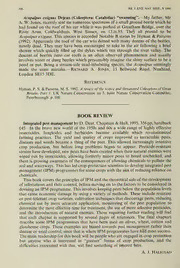
Acupalpus exiguus Dejean (Coleoptera: Carabidae) "swarming" PDF
Preview Acupalpus exiguus Dejean (Coleoptera: Carabidae) "swarming"
— 106 BR.J.ENT.NAT.HIST.,9: 1996 — Acupalpus exiguus Dejean (Coleoptera: Carabidae) "swarming". My father, Mr A. W. Jones, recentlysentmenumerous specimensofa smallgroundbeetlewhichhe had found on the roofofhis car while it was parked at Greatham Bridge, over the River Arun, Coldwaltham, West Sussex, on 13.ix.95. They all proved to be Acupalpus exiguus. This species is accorded Notable B status by Hyman & Parsons (1992). Apparently the roofofthe car was dotted with many dozens ofthe beetles, mostly dead. They may have been encouraged to take to the air following a brief shower which quickly filled up the dykes which run through the river valley. The descent of beetles onto car roofs is an often observed phenomenon and usually involves water or dung beetles which presumably imagine the shiny surface to be a pond or pat. Being a stream-side mud-inhabiting species, the Acupalpus seemingly made the same mistake. Richard A. Jones, 13 Bellwood Road, Nunhead, London SE15 3DE. Reference Hyman,P. S. &Parsons, M. S. 1992. A reviewofthescarceandthreatenedColeopteraofGreat Britain. Part 1. UK Nature Conservation no 3. Joint Nature Conservation Committee, Peterborough, p. 100. BOOK REVIEW In—tegratedpestmanagementby D. Dent. Chapman & Hall, 1995, 356pp, hardback £45 In the brave new world ofthe 1950s and 60s a wide range ofhighly effective insecticides, fungicides and herbicides became available which revolutionized farming practices. The yield and quality of crops improved as intractable pests, diseases and weeds became a thing of the past. This allowed increasingly intensive crop production, but before long problems began to appear. Pesticide-resistant strains havedeveloped, newpestshave beencreated when theirnatural enemieswere wiped out by insecticides, allowing formerly minor pests to breed unchecked, and there is growing awareness ofthe consequences ofallowing chemicals to pollute the soiland waterways. Thishas ledcrop-protection scientists todevelop integrated pest management (IPM) programmesforsomecropswiththeaim ofreducingrelianceon chemicals. Thisbookcoverstheprinciples ofIPM and thetheoretical sideofthedevelopment ofinfestations and theircontrol, beforemoving on to the factors to beconsidered in devisingan IPM programme. Thisinvolveskeepingpestsbelowthepopulationlevels that cause economic damage by using a variety ofmethods. These include resistant orpest-tolerantcropvarieties, cultivation techniques that discourage pests, reducing chemical use by more accurate application, monitoring of the pest population to determine the most effective time for treatment, the use ofmore selective pesticides, and the introduction of natural enemies. Those requiring further reading will find that each chapter is supported by several pages of references. The final chapters describe some IPM programmes that have been used on olives, wheat, cotton and glasshouse crops. These examples are biased towards pest management rather than disease orweed control, sincethat iswhere IPM programmeshavehadmostsuccess. Themain readershipforthisbookwill bepeoplewho areengagedincropprotection but anyone who is interested in "greener" forms of crop production, and the difficulties associated with this, will find something ofinterest here. A. J. Halstead
